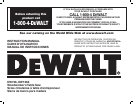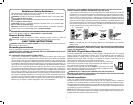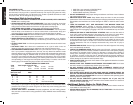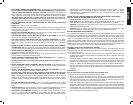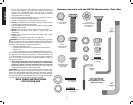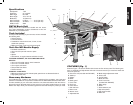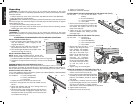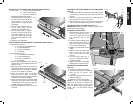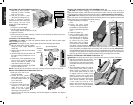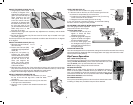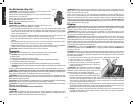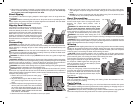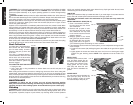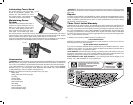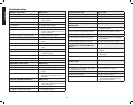
2
English
• ANSI Z87.1 eye protection (CAN/CSA Z94.3)
• ANSI S12.6 (S3.19) hearing protection
• NIOSH/OSHA respiratory protection.
• DO NOT OVERREACH. Keep proper footing and balance at all times. Loss of balance
may cause personal injury.
• MAINTAIN TOOLS WITH CARE. Keep blades sharp and clean for best and safest
performance. Follow instructions for lubricating and changing accessories. Poorly main-
tained blades and machines can further damage the blade or machine and/or cause
injury.
• TURN THE MACHINE “OFF”, AND DISCONNECT THE MACHINE FROM THE
POWER SOURCE before installing or removing accessories, before adjusting or
changing set-ups, when making repairs or changing locations. Do not touch the plug’s
metal prongs when unplugging or plugging in the cord. An accidental start-up can cause
injury.
• REDUCE THE RISK OF UNINTENTIONAL STARTING. Make sure that the switch is
in the “OFF” position before plugging in the power cord. In the event of a power failure,
move the switch to the “OFF” position. An accidental start-up can cause injury.
• USE RECOMMENDED ACCESSORIES. Use only accessories that are recommended
by the manufacturer for your model. Accessories that may be suitable for one tool may
be hazardous when used on another tool. Consult the instruction manual for recom-
mended accessories. The use of improper accessories may cause risk of injury to
persons.
• NEVER STAND ON TOOL. Serious injury could occur if the tool is tipped or if the cutting
tool is unintentionally contacted.
• CHECK FOR DAMAGED PARTS. Before further use of the tool, a guard or other part
that is damaged should be carefully checked to determine that it will operate properly
and perform its intended function—check for alignment of moving parts, binding of
moving parts, breakage of parts, mounting and any other conditions that may affect
its operation. A guard or other part that is damaged should be properly repaired or
replaced. Do not use tool if switch does not turn it on and off. Damaged parts can cause
further damage to the machine and/or personal injury.
• DIRECTION OF FEED. Feed work into a blade or cutter against the direction of rotation
of the blade or cutter only.
• NEVER LEAVE TOOL RUNNING UNATTENDED. TURN POWER OFF. Don’t leave
tool until it comes to a complete stop. Serious injury can result.
• DO NOT OPERATE ELECTRIC TOOLS NEAR FLAMMABLE LIQUIDS OR IN
GASEOUS OR EXPLOSIVE ATMOSPHERES. Motors and switches in these tools may
spark and ignite fumes.
• STAY ALERT, WATCH WHAT YOU ARE DOING AND USE COMMON SENSE. DO
NOT USE THE MACHINE WHEN YOU ARE TIRED OR UNDER THE INFLUENCE OF
DRUGS, ALCOHOL OR MEDICATION. A moment of inattention while operating power
tools may result in serious injury.
• DO NOT ALLOW FAMILIARITY (gained from frequent use of your saw) TO
REPLACE SAFETY RULES. Always remember that a careless fraction of a second is
sufficient to inflict severe injury.
Additional Safety Rules for Table Saws
• AVOID AWKWARD POSITIONS, where a sudden slip could cause a hand to move into
a saw blade or other cutting tool.
• NEVER REACH IN BACK OF, OR AROUND, THE CUTTING TOOL with either hand to
hold down the workpiece.
POLARIZED PLUGS
To reduce the risk of electric shock, this equipment has a polarized plug (one blade is wider
than the other). This plug will fit in a polarized outlet only one way. If the plug does not fit fully
into the outlet, reverse the plug. If it still does not fit, contact a qualified electrician to install
the proper outlet. Do not change the plug in any way.
Important Safety Instructions
• TO REDUCE THE RISK OF KICKBACK AND OTHER INJURIES, KEEP GUARDS IN
PLACE and in working order.
• REMOVE ADJUSTING KEYS AND WRENCHES. Form habit of checking to see that
keys and adjusting wrenches are removed from spindle before turning tool on. Tools,
scrap pieces and other debris can be thrown at high speed, causing injury.
• KEEP WORK AREA CLEAN. Cluttered areas and benches invite accidents.
• DO NOT USE THE MACHINE IN A DANGEROUS ENVIRONMENT. The use of power
tools in damp or wet locations or in rain can cause shock or electrocution. Keep your
work area well-lit to avoid tripping or placing arms, hands and fingers in danger.
• KEEP CHILDREN AWAY. All visitors should be kept at a safe distance from work area.
Your shop is a potentially dangerous environment.
• MAKE WORKSHOP CHILDPROOF with padlocks, master switches, or by removing
starter keys. The unauthorized start-up of a machine by a child or visitor may result in
injury.
• DO NOT FORCE TOOL. It will do the job better and be safer at the rate for which it was
designed.
• USE RIGHT TOOL. Don’t force tool or attachment to do a job for which it was not
designed. Using the incorrect tool or attachment may result in personal injury.
• USE PROPER EXTENSION CORD. Make sure your extension cord is in good condi-
tion. If your product is equipped with a cord set, use only three-wire extension cords
that have three-prong grounding-type plugs and three-pole receptacles that accept the
tool’s plug. When using an extension cord, be sure to use one heavy enough to carry
the current your product will draw. An undersized cord will cause a drop in line voltage
resulting in loss of power and overheating. The following table shows the correct size to
use depending on cord length and nameplate ampere rating. If in doubt, use the next
heavier gauge. The smaller the gauge number, the heavier the cord.
MINIMUM GAUGE FOR CORD SETS
Volts Total Length of Cord in Feet
120V 0-25 26-50 51-100 101-150
240V 0-50 51-100 101-200 201-300
Ampere Rating
More Not more AWG
Than Than
0 - 6 18 16 16 14
6 - 10 18 16 14 12
10 - 12 16 16 14 12
12 - 16 14 12 Not Recommended
• WEAR PROPER APPAREL. No loose clothing, gloves, neckties, rings, bracelets or
other jewelry to get caught in moving parts. Non-slip footwear is recommended. Wear
protective hair covering to contain long hair. Air vents may cover moving parts and
should also be avoided.
• ALWAYS USE SAFETY GLASSES. Everyday eyeglasses are NOT safety glasses.
Also use face or dust mask if cutting operation is dusty. ALWAYS wear certified safety
equipment:



